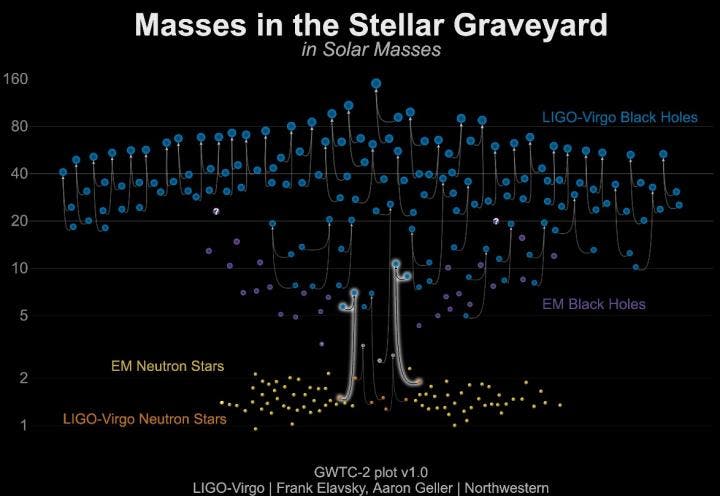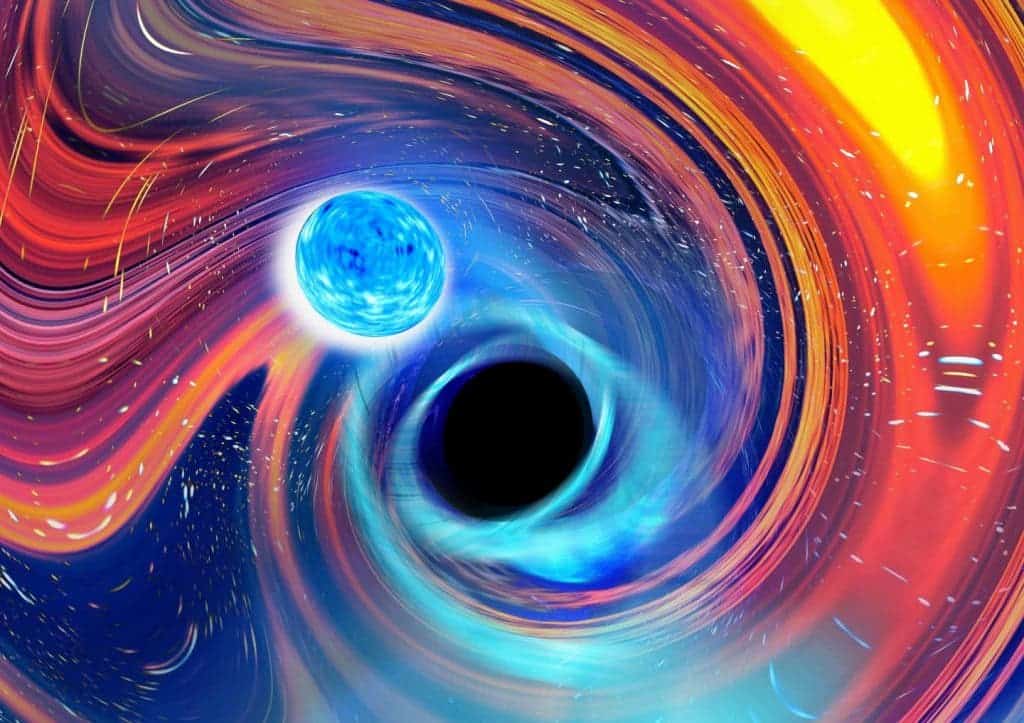Astrophysicists have finally observed the spiralling merger between a neutron star and a black hole. The cataclysmic event was witnessed in a gravitational wave signal by the LIGO/Virgo/KAGRA collaboration and is the first time that one of these elusive but titanic ‘mixed’ merger events has been spotted and had its nature confirmed. And just like buses, you wait for an age for one to come and then two arrive at once.
The researchers also detected a gravitational wave signal from another event of the same nature just ten days after the first, with the signals picked up by LIGO/Virgo on 5th January 2020 and the 15th January 2020 respectively.
The finding is significant because of the three types of mergers between stellar remnant binaries–neutron star/neutron star mergers, black hole/ black hole mergers, and neutron star/ black hole or mixed mergers–this latter category is the only one we hadn’t detected until now and has proved fairly elusive.
“With this new discovery of neutron star- black hole mergers outside our galaxy, we have found the missing type of binary,” says Astrid Lamberts, a CNRS researcher at Observatoire de la Côte d’Azur, in Nice, France. “We can finally begin to understand how many of these systems exist, how often they merge, and why we have not yet seen examples in the Milky Way.”
These detections of signals from separate mixed merger events come just six years after the LIGO/Virgo collaboration first detected the gravitational waves confirming predictions regarding ripples in the fabric of spacetime by Einstein’s theory of general relativity a century previous.
Though further observations are needed, the results produced by the team could help astronomers and astrophysicists refine their knowledge of systems in which these elusive mergers occur determining both how these mixed binary pairings form and how frequently their components spiral together and merge.
“Gravitational waves have allowed us to detect collisions of pairs of black holes and pairs of neutron stars, but the mixed collision of a black hole with a neutron star has been the elusive missing piece of the family picture of compact object mergers,” says Chase Kimball, a Northwestern University graduate student. “Completing this picture is crucial to constraining the host of astrophysical models of compact object formation and binary evolution. Inherent to these models are their predictions of the rates that black holes and neutron stars merge amongst themselves.
“With these detections, we finally have measurements of the merger rates across all three categories of compact binary mergers.”
Chase Kimball, Northwestern University
Kimball is the co-author of a study published in the Astrophysical Journal Letters and part of a team that includes researchers from the LIGO Scientific Collaboration (LSC), the Virgo Collaboration and the Kamioka Gravitational Wave Detector (KAGRA) project.
A Gravitational-Wave Signal Signal One Billion Years in the Making
One of the most astounding things about the detection of gravitational waves is just how precise a piece of equipment has to be to detect these tiny ripples in the fabric of spacetime. Since that first key detection in 2015, the National Science Foundation’s (NSF) operators at the LIGO laser interferometer and their counterparts at the Virgo detector in Italy have detected over 50 gravitational wave signals from mergers between black hole pairs and neutron star binaries.
The first mixed neutron star/black hole merger spotted by the collaboration on January 5th is believed to be the result of a merger of a black hole six times the mass of the Sun and a neutron star with a mass 1.5 times that of our star. The event which has been designated GW200105 occurred 900 million light-years away from Earth and was picked up as a strong signal at the LIGO detector located in Livingstone, Louisiana.

LIGO Livingstone’s partner detector located in Hanford, Washington, missed the signal as it was offline at the time. Virgo on the other hand caught the signal but it was somewhat obscured by noise. “Even though we see a strong signal in only one detector, we conclude that it is real and not just detector noise,” says Harald Pfeiffer, group leader in the Astrophysical and Cosmological Relativity department at Max Planck Institute for Gravitational Physics (AEI) in Potsdam, Germany. “It passes all our stringent quality checks and sticks out from all noise events we see in the third observing run.”
The fact that GW200105 was only strongly picked up by one detector makes it difficult to pinpoint in the sky with the international team only able to ascertain that it came from a region about 34 thousand times the size of the Moon.
“While the gravitational waves alone don’t reveal the structure of the lighter object, we can infer its maximum mass,” says Bhooshan Gadre, a postdoctoral researcher at the AEI. “By combining this information with theoretical predictions of expected neutron star masses in such a binary system, we conclude that a neutron star is the most likely explanation.”
Despite the fact that the second mixed merger occurred farther away–1 billion light-years distant from Earth– its signal was spotted by both LIGO detectors and the Virgo detector. This means that the team have been able to localise the merger–named GW200115– more precisely, to a region of the sky that is around three thousand times the size of Earth’s moon. This second merger is believed to have occurred between a black hole nine times the mass of our Sun and a neutron star almost twice the size of the Sun.
These Black Holes Weren’t Messy Eaters
Because of the extraordinary distances involved, astronomers have yet to confirm either merger in the electromagnetic spectrum upon which traditional astronomy is based. Despite being informed of the event almost immediately astronomers could not find telltale flashes of light indicating the mergers.
This is unsurprising as any light from such distant events would be incredibly dim after one billion years of journeying to Earth no matter what wavelength it is observed in, or how powerful the telescope is that is used to attempt the follow-up observation.
There also remains another possibility why no light could be seen from these events. The lack of a signal in electromagnetic radiation could be because the neutron star elements of these mergers were swallowed whole by their black hole partners.
“These were not events where the black holes munched on the neutron stars like the cookie monster and flung bits and pieces about,” explains Patrick Brady, a professor at the University of Wisconsin-Milwaukee and Spokesperson of the LIGO Scientific Collaboration, colourfully. “That ‘flinging about’ is what would produce light, and we don’t think that happened in these cases.”
Whilst these are the first two confirmed examples of such mixed mergers, there have been suspects spotted by their gravitational-wave signals in the past. In August 2019 a signal designated GW190814 was detected which researchers say involved a collision of a 23-solar-mass black hole with an object of about 2.6 solar masses. This second object could have been either the heaviest known neutron star or the lightest known black hole ever found. That ambiguity left this signal unconfirmed as the product of a mixed merger event and other similar finds have been plagued with similar ambiguities.
Now that two confirmed detections of mixed mergers have been made, astrophysicists can set about discovering if current estimates that say such collisions should occur at a frequency of around one per month within a distance of 1 billion light-years of Earth are correct.
They can also set about discovering the origins of such binaries, possibly eliminating one or two of the proposed locations in which such events are believed to occur: stellar binary systems, dense stellar environments including young star clusters, and the centers of galaxies.
Key to these investigations will be the fourth observation run of the laser interferometers that act as our gravitational wave detectors, set to begin in summer 2022.
“The detector groups at LIGO, Virgo, and KAGRA are improving their detectors in preparation for the next observing run scheduled to begin in summer 2022,” concludes Brady. “With the improved sensitivity, we hope to detect merger waves up to once per day and to better measure the properties of black holes and super-dense matter that makes up neutron stars.”







